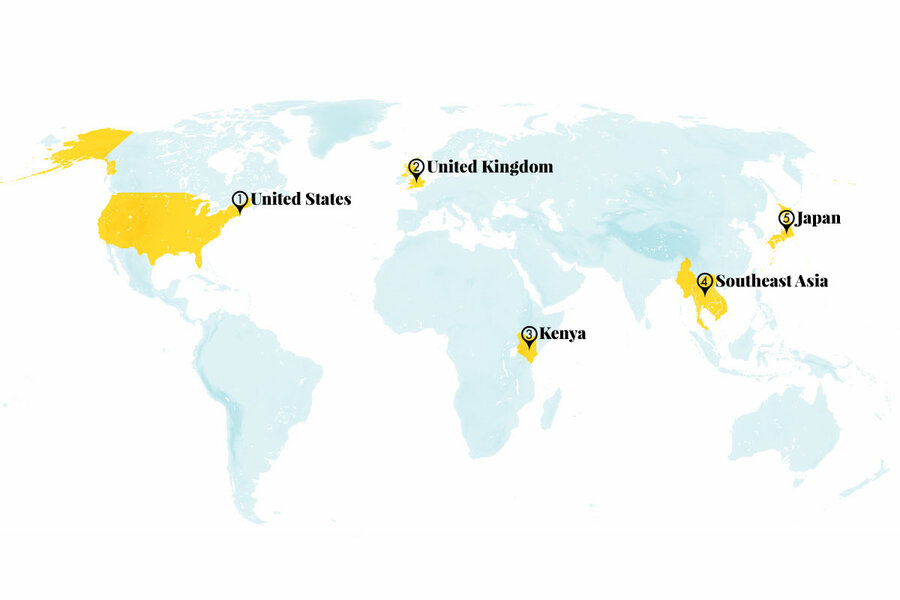Snakes, bats, and rocks, anyone? New species and a deep dig into Earth.
Loading...
1. United States
Scientists have dug up a significant length of rock from the Earth’s mantle for the first time. The achievement will help geologists study how volcanoes work via the substance that makes up 84% of the planet’s volume. The mantle begins about 5 miles below the ocean floor and 20 miles beneath continents.
The team of geoscientists, led by Andrew McCaig from the University of Leeds in England and Susan Lang with Woods Hole Oceanographic Institution, set out to explore microbes trapped in rock beneath the ocean that could shed light on Earth’s earliest life forms.
Why We Wrote This
A story focused onIn our progress roundup, scientists delve deep below the ocean floor and across the biodiverse terrestrial hot spots of Southeast Asia. When these researchers use words like “dream” and “wonder,” their work can inspire us, too.
They drilled into an underwater mountain in the North Atlantic where mantle rocks have pushed relatively close to the surface – creating a “tectonic window” – and pulled up long samples from as deep as 4,157 feet below the ocean floor.
“We’ve achieved an ambition that’s been feeding the science community for many decades,” said Dr. McCaig.
Scientists know from samples ejected by volcanic eruptions that the mantle is made up mostly of peridotite, which dominated the newly drilled cores. They are working to determine how representative these samples are and how seawater may have contaminated them.
Sources: The Washington Post, Science
2. United Kingdom
Innovators in the United Kingdom are making strides toward zero-emissions flight. A hydrogen-electric-powered Dornier 228 flew for 10 minutes in January – the first such flight for a larger, 19-seat plane.
Several airlines – and Amazon – have invested in ZeroAvia, which is developing the hydrogen-electric powertrain to replace traditional engines. Airlines have preordered 1,500 of the new engines, which will be used for shorter, regional routes and cargo flights. The company is also working to encourage airport infrastructure that accommodates on-site fuel production, and with companies that can make green hydrogen that leaves no carbon footprint.
The aviation industry contributes over 2% of the world’s CO2 emissions but has pledged to reach net-zero carbon emissions by 2050.
“The technology will get there,” said ZeroAvia CEO Val Miftakhov. “Whether it’s through incentives for zero emissions, or disincentives for fossil fuel, I think it can be done.”
Sources: Fast Company, International Energy Agency, Zeroavia
3. Kenya
Kenya is expanding programs that invite local input to address climate change, reducing the risk of maladaptation – when intended solutions are more harmful than helpful. Kenya launched its Adaptation Consortium in 2010 after a reservoir commissioned by Nairobi disrupted grazing patterns – a problem that could have been avoided by consulting local herders. The loss of grazing increased the risk of drought instead of abating it, and the reservoir was replaced by a well that better suited local needs.
More than a decade later, success of the Adaptation Consortium in five counties spurred demand from the rest of the country. In 2021, the Financing Locally Led Climate Action Program – backed by the World Bank and supporting countries – launched with the goal of reaching all of Kenya’s 1,450 wards. The idea also follows the general devolution of government control to 47 counties, following directives in Kenya’s 2010 Constitution to decentralize the government.
A 2022 United Nations report said that wealthy nations set aside $29 billion to help developing countries adapt to climate change – five to 10 times less than what is needed by 2030.
Communities can organize to “participate in the climate process in terms of identifying and prioritising where to invest the climate funds,” said Victor Orindi, national coordinator of the Adaptation Consortium.
Sources: Context, World Bank
4. Southeast Asia
Researchers discovered 380 new species living in Cambodia, Laos, Myanmar, Thailand, and Vietnam. Hundreds of contributors compiled a World Wildlife Fund (WWF) report detailing 46 reptiles, 24 amphibians, 19 fishes, 290 plants, and one bat from the Greater Mekong region from 2021 to 2022. Some of the work spanned generations: In one case, a plant collected in the 1930s was just confirmed as a novel species.
Highlights include a miniature, bright pink and yellow orchid named Dendrobium fuscifaucium that was discovered in Laos; a Cambodian blue-crested agama, an aggressive lizard that changes color when threatened; a type of splendid perch found off the coast of Myanmar, with a larger head, differently shaped tail, and bright coloring that is distinct from other perch; and two different toads endemic to Thailand. The Karen stream toad, found in western Thailand’s Tenasserim mountains, was named for the local Karen people who supported researchers. The tiny, reddish-orange Ansonia infernalis lives in fast-moving streams on the Thai-Malay Peninsula and is less than 30 millimeters long.
While exciting for experts, the discovery comes with a reminder of the variety of threats facing biodiversity. “We must continue to invest in the protection and conservation of nature,” said WWF-U.S. Asian species manager Nilanga Jayasinghe, “so these magnificent species don’t disappear before we know of their existence.”
Sources: Nice News, World Wildlife Fund
5. Japan
Vending machines are aiding disaster preparedness in Japan. Selling items for payment under normal circumstances, the machines are programmed to dispense food and emergency supplies free of charge if a major earthquake or typhoon strikes. Holding about 300 soft drinks and 150 food items, two of the machines were installed by the local government near evacuation shelters in Ako, on the western coast.
In Tokyo, a different, radio-equipped vending machine will broadcast alerts for earthquakes, with evacuation and other emergency information. At least 30 local radio stations have set up similar vending machine radios across the country.
Japan has the most vending machines per capita in the world and thousands of earthquakes every year. It sits in the circum-Pacific seismic belt, where 81% of the world’s largest earthquakes take place.
Sources: The Guardian, The Mainichi










